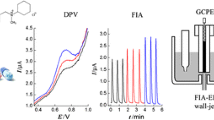Summary
Two forms of micro titration cup incorporating a coulometric working electrode and differential indicating electrodes are described, together with a capillary lock auxiliary electrode. These have been used for the differential electrolytic potentiometric titration of hydrazine with coulometrically generated bromine. Satisfactory determinations have been made over the range of 10−10 mole at millimolar concentration with an accuracy of ± 0.1%, down to 5 · 10−10 mole at micromolar concentration with an accuracy of ±5%. There exists a practical lower limit for the generating current of about 10μA, below which bromine losses are sufficiently rapid to engender serious experimental difficulties.
Zusammenfassung
Zwei Formen eines Mikrotitrationsgefäßes werden beschrieben, die mit einer coulometrischen Arbeitselektrode, Umschlagselektroden und einer kapillar verschlossenen Hilfselektrode versehen sind. Diese wurden für differenzialelektrolytische, potentiometrische Titrationen von Hydrazin durch coulometrisch erzeugtes Brom verwendet. Zufriedenstellende Bestimmungen von 10−6 Mol in 10−3-m Konzentration bis zu 5 · 10−10 Mol in 10−6-m Konzentration mit einer Genauigkeit von ± 0,1% bzw. ± 5% wurden ausgeführt. Praktisch liegt die untere Grenze für die Arbeitsstromstärke bei etwa 10μA, unterhalb deren Bromverluste so rasch eintreten, daß dadurch bedeutende experimentelle Schwierigkeiten verursacht werden.
Résumé
On a décrit deux formes de vases de microtitrage en associant une électrode coulométrique et des électrodes différentielles avec une électrode capillaire auxiliaire de sûreté. Celles-ci ont été utilisées pour le titrage potentiométrique électrolytique différentiel de l'hydrazine avec formation de brome par coulométrie. Des dosages satisfaisants ont été faits dans le domaine de 10−6 mole pour une concentration millimolaire avec une précision de ± 0,1%, jusqu'à 5 · 10−10 mole à la concentration micromolaire, avec une précision de ±5%. Dès ce moment, existe une limite inférieure pratique pour le courant engendrant le brome, d'environ 10μA, au-dessous de laquelle les pertes en brome sont suffisamment rapides pour donner de sérieuses difficultés expérimentales.
Similar content being viewed by others
References
E. Bishop, Mikrochim. Acta [Wien]1956, 619.
E. Bishop, Proceedings of the International Symposium on Michrochemistry. Birmingham, 1958. London: Pergamon Press. 1960. pp. 429, 438.
S. S. Lord, R. C. O'Neill, andL. B. Rogers, Analyt. Chemistry24, 209 (1952);-K. W. Gardiner andL. B. Rogers, Analyt. Chemistry25, 1393 (1953).
W. D. Cooke, C. N. Reilley, andN. H. Furman, Analyt. Chemistry24, 205 (1952).
L. Meites, Analyt. Chemistry24, 1057 (1952).
R. Schreiber andW. D. Cooke, Analyt. Chemistry27, 1475 (1955).
J. A. Page andJ. J. Lingane, Analyt. Chim. Acta16, 175 (1957).
E. Bishop, Analyst83, 212 (1958).
E. Bishop, Analyst85, 122 (1960).
Author information
Authors and Affiliations
Additional information
On the occasion of the hundredth return ofFriedrich Emich's birthday.
Rights and permissions
About this article
Cite this article
Bishop, E. Differential electrolytic potentiometry. IV. Mikrochim Acta 48, 803–815 (1960). https://doi.org/10.1007/BF01216068
Received:
Issue Date:
DOI: https://doi.org/10.1007/BF01216068



